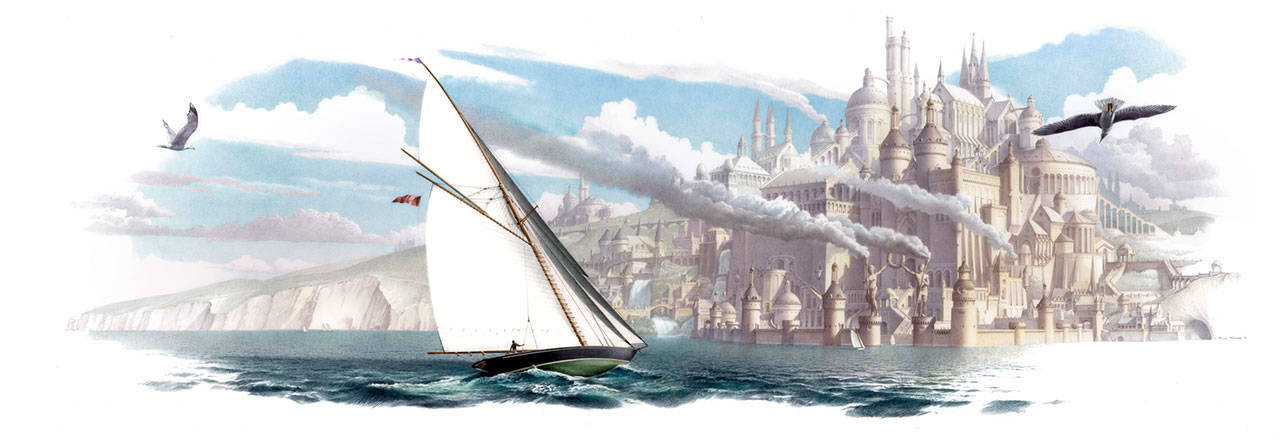Once upon a time — about 20 years ago — a father, his young daughter and their dog set out in a dinghy to row to a deserted island with sand made for castles. Soon, a palace appeared populated by a myriad of drip-people and the surrounding rocks lumbered up out of the sand in the shape of hippos and elephants and turtles — oh my. The father bid a sweet farewell to his daughter, for he had to sail away on an important mission, leaving her in charge of defending the castle from the ravages of waves grown strong from impending storms. Upon his return, he was greeted by a happy daughter and community living in a magnificent castle.
And so began a family fairy tale brought to life through imagination and plastic pencil on film that culminated in 25 images for a new book, “And Then?” Drawn by Bruce Morser, the story is a collaboration between my husband and our daughter, Madeline.
For the month of October, the original drawings and printed pages of the book will line the walls of Vashon Center for the Arts’ Koch Gallery. Morser will give a talk at 5:30 p.m. Friday, Oct. 6, at VCA, followed by the show’s opening from 6 to 9 p.m.
Like many tales, the idea for this one came from experience — summer vacations building sand castles — but the story line, Morser said, mostly wrote itself.
“I was picking up on what Madeline was doing and trying to see it through her eyes,” he said. “I thought of it as a coming-of-age story. I watched her make profound leaps by learning to row and spending a day with total freedom to build these castles, knowing they’ll all disappear when the tide came back in. She knew I was there, but I could see she’d taken charge of the creative process, imaging the 1- to 2- inch people who lived in the castle, naming them like we named the rocks on the beach that she saw as hippos and elephants. Feeling independent of the father, when in reality all I did was walk back to the dinghy to get a snack, opened up this huge time expansion that she filled with imagination.”
As the story developed, Morser started drawing, trying to “give visual substance to the narrative we had between us.” After the father leaves to sail across the ocean in search of treasure, and the fierce storm arrives, the daughter saves the castle with the help of her dog and the beach animals — the rocks that arise as hippos, elephants and turtles and the drip-people who morph into citizens working shoulder to shoulder to safeguard the castle.
“A theme in the book is about my dad trusting me with what he started and of being a capable worker,” Madeline said. “Another was about the energy that happens with the collision of waves and sand at the shore, something I learned to love growing up on Vashon and visiting the coasts.”
With the story line down, Morser then took storyboard sketches to the Harbor School and presented them to the students.
“I knew the opinions and voices of the youth would be important, so thanks to Kathy Larsdotter, the school’s art teacher, we took the story to Madeline’s old classroom,” he said.
Over several visits, Morser showed parts of the book to the students who would give him feedback. He’d then work some of the ideas into the next part of the book, keeping the story on track for what appealed to fourth through eighth graders. The students also played a role in determining whether the drawings remained in black and white or should be colorized. Several publishers pushed for the color.
“I showed the color versions to the kids, but like me, they liked the black and white,” Morser said. “Somehow it’s easier to be in fantasy land if it’s in black and white. As an illustrator, you always want to leave a bit for the viewer to do.”
For the past 40 years, Morser has worked as a freelance illustrator and artist. His pencil and digital images are internationally recognized and appear in publications from National Geographic Magazine to The Wall Street Journal. This is his first children’s book and though he is used to making imagery on deadlines and on budget, he’s worked on this book for close to two decades, fitting it in around assignments. His pre-opening talk will “create the context for the story and why the images are so different from what people normally think of me as generating,” he said.
“The research, design, composition, story line, perspective — the drawing was arduous. But at some point they came together out of the mist of toil to a heartfelt connection with my family and the beaches on the East coast. That joy is the pay off,” he said.
Madeline, who is now a professional dancer, reflected that she really liked being part of the process and learned a lot about balance from it.
“I’m really proud of the book, and that he finished it,” she said with a laugh. “Being an artist, I have laundry, cooking, teaching to do and never think I have time for choreography, but I do. It gives me confidence that even if it takes 20 years, you can get it done. Connecting that knowledge with the magic of the water and shore really is a fairy tale come true.”


